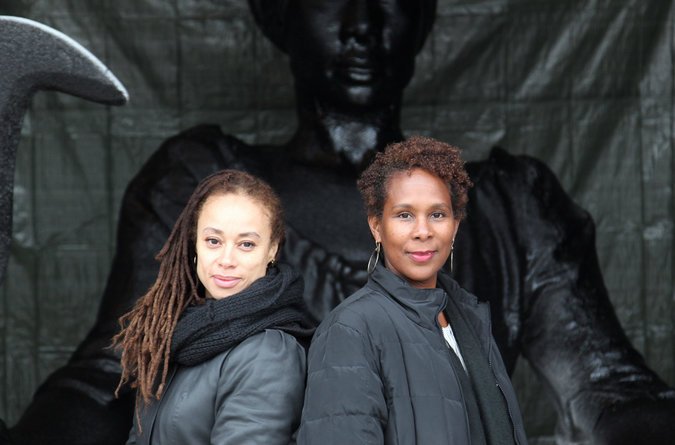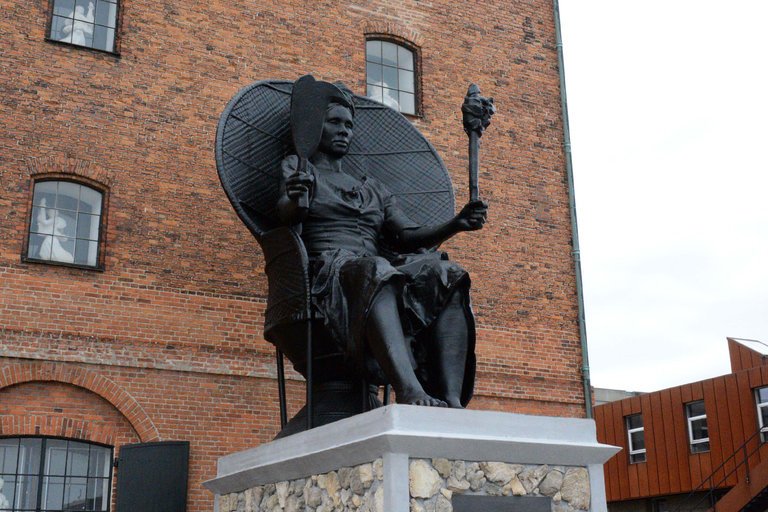Denmark Gets Statue of a ‘Rebel Queen’ Who Led Fiery Revolt Against Colonialism
COPENHAGEN — The statue of the woman is nearly 23 feet tall. Her head is wrapped and she stares straight ahead while sitting barefoot, but regally, in a wide-backed chair, clutching a torch in one hand and a tool used to cut sugar cane in the other.
In Denmark, where most of the public statues represent white men, two artists on Saturday unveiled the striking statute, portraying a 19th-century rebel queen who led a fiery revolt against Danish colonial rule in the Caribbean.
It’s being billed as Denmark’s first public monument to a black woman.
The sculpture was inspired by Mary Thomas, who with two other female leaders known as “Queens” unleashed an uprising in 1878 called the “Fireburn.” Fifty plantations and most of the town of Frederiksted on the west coast of St. Croix were torched, in what has been called the largest labor revolt in Danish colonial history.
“This project is about challenging Denmark’s collective memory and changing it,” the Virgin Islands artist La Vaughn Belle, one of two principal forces behind the statue, said in a statement.
Advertisement
Continue reading the main story
The unveiling comes at the end of a centennial year commemorating the sale by Denmark of three islands to the United States on March 3, 1917: St. Croix, St. John and St. Thomas. The price: $25 million.
Continue reading the main story
Though Denmark prohibited trans-Atlantic slave trafficking in 1792, it didn’t rush to enforce the ban. The rule took effect 11 years later, and slavery continued until 1848.
“They wanted to fill the stocks first,” and ensure enough slaves would remain to keep plantations running, said Niels Brimnes, an associate professor from Aarhus University and a leading expert on colonialism in Denmark.
Three decades after slavery formally ended on what are today known as the United States Virgin Islands, conditions for the former slaves had not improved significantly. That continued injustice fomented the uprising on St. Croix.
Mary Thomas was tried for her role in the rebellion and ferried across the Atlantic to a women’s prison in Copenhagen. The statue created in tribute to her, called “I Am Queen Mary,” now sits in front of what was once a warehouse for Caribbean sugar and rum, just more than a mile from where she was jailed.

The only other tribute to Denmark’s colonies or those who were colonized is a statue of a generic figure from Greenland.
The Danish artist Jeannette Ehlers, who teamed up with Ms. Belle to create the “Queen Mary” monument, said, “Ninety-eight percent of the statues in Denmark are representing white males.”
The torch and the cane bill held in the statue’s hands symbolize the resistance strategies by those who were colonized, the artists said in a statement. Her seated pose “recalls the iconic 1967 photograph of Huey P. Newton, founder of the Black Panther Party.”
Newsletter Sign Up
Continue reading the main story
Please verify you're not a robot by clicking the box.
Invalid email address. Please re-enter.
You must select a newsletter to subscribe to.
Sign Up You agree to receive occasional updates and special offers for The New York Times's products and services.
Thank you for subscribing.
An error has occurred. Please try again later.
You are already subscribed to this email.
View all New York Times newsletters.
- See Sample
- Manage Email Preferences
- Not you?
- Privacy Policy
- Opt out or contact us anytime
And the plinth on which her chair rests incorporates “coral cut from the ocean by enslaved Africans gathered from ruins of the foundations of historic buildings on St. Croix.”
Advertisement
Continue reading the main story
Henrik Holm, senior research curator at Denmark’s National Gallery of Art, said in a statement: “It takes a statue like this to make forgetting less easy. It takes a monument like this to fight against the silence, neglect, repression and hatred.”
He added: “Never before has a sculpture like this been erected on Danish soil. Now, Denmark is offered a sculpture that addresses the past. But it is also an artwork for the future.”
The preferred self-image of this country of 5.5 million is that of a nation at the forefront of democratization and a savior of Jews during World War II. And even though the Vikings raped and pillaged their way around the shores of Britain and Ireland, the Viking Age is generally a source of national pride and amusement in Denmark.
Over the centuries, Danes have not undergone a national reckoning about the thousands of Africans forced onto Danish ships to work the plantations in Danish colonies in the Caribbean, historians say.
“It may have to do with the narrative of Denmark as a colonial power saying, ‘We weren’t as bad as others,’ ” Professor Brimnes said. “But we were just as bad as the others. I can’t identify a particular, humane Danish colonialism.”
In a speech last year, the Danish prime minister, Lars Lokke Rasmussen, expressed regret for his country’s part in the slave trade — but he stopped short of an apology.
“Many of Copenhagen’s beautiful old houses were erected with money made on the toil and exploitation on the other side of the planet,” he said. “It’s not a proud part of Denmark’s history. It’s shameful and luckily of the past.”
Continue reading the main story Read the Original Article






























